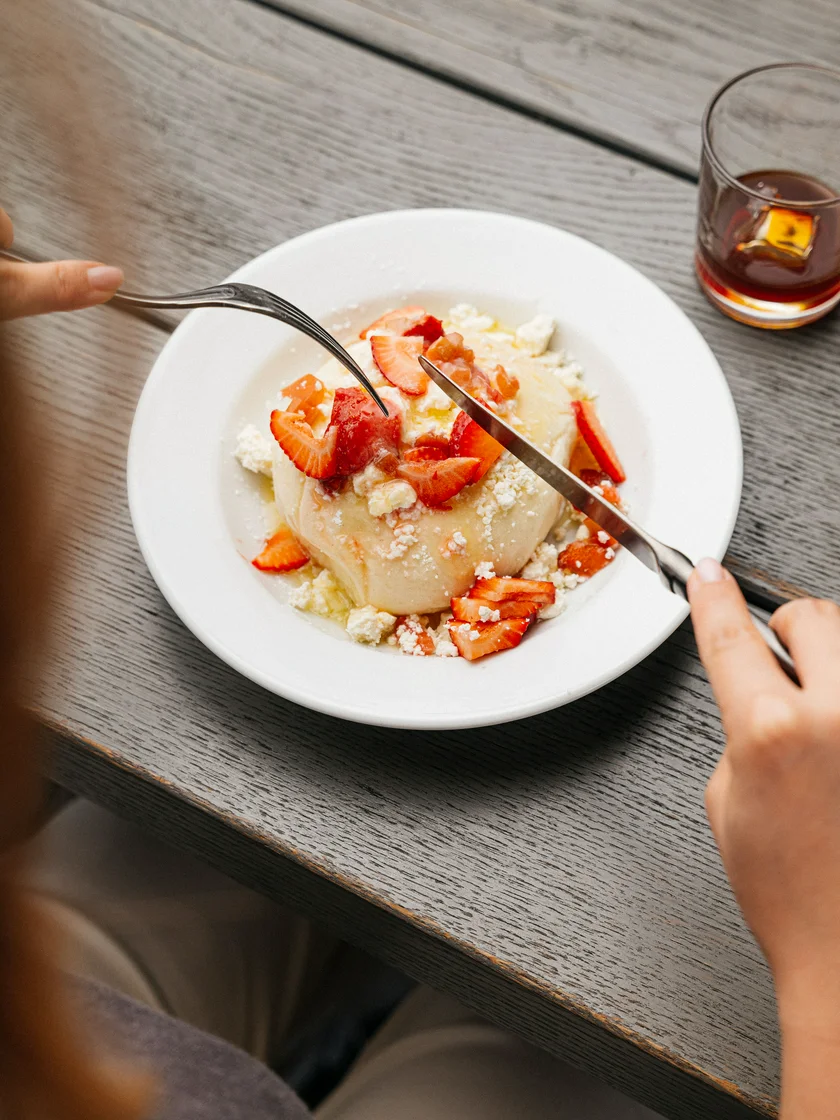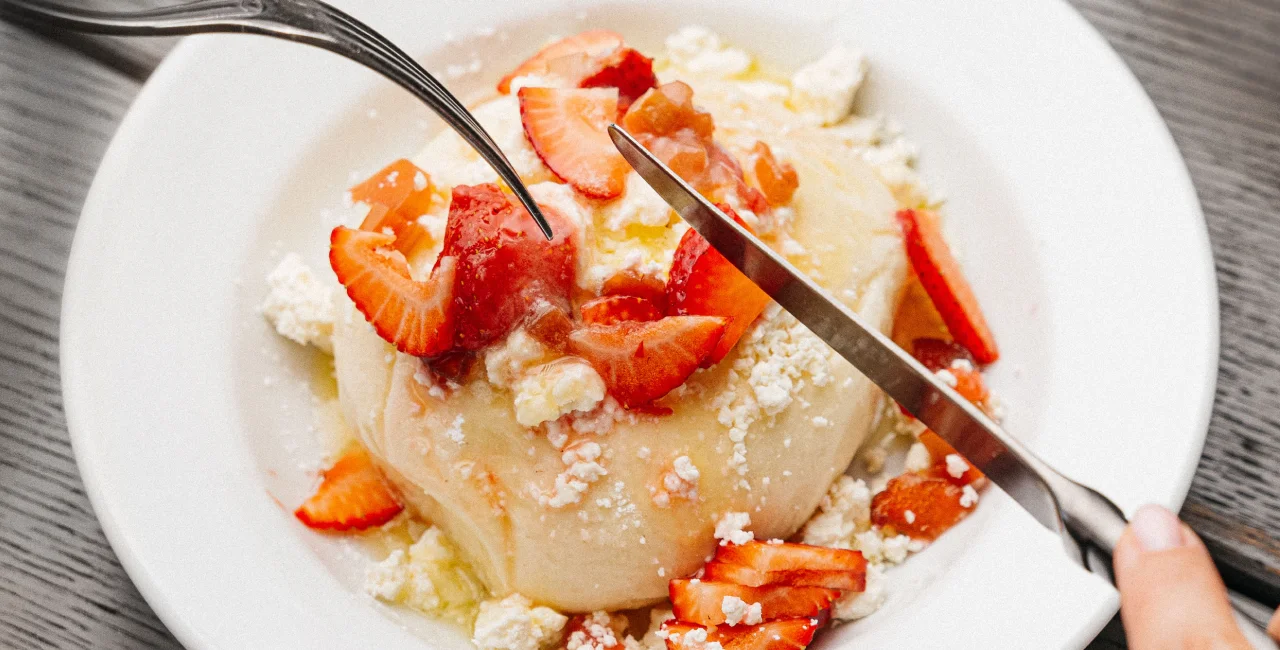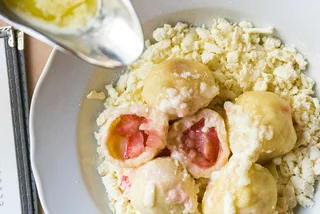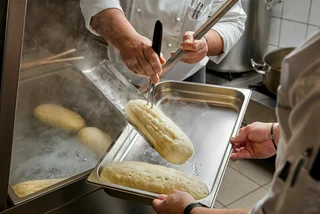Kuchyň restaurant, located near the gates of Prague Castle is renowned for serving traditional and tasty Czech cuisine in a setting that can best be described as a fairytale grandma's kitchen.
One of the most beloved dishes on their menu is a giant yeasted dumpling (kynutý knedlík), a fluffy pillow of dough encasing juicy seasonal fruit. The "castle's kitchen" has shared its recipe with us. Use your favorite seasonal fruit (cherries, apricots, peaches, plums) to try this Czech favorite at home.
A dumpling with a Viennese cousin
Fruit dumplings are considered a specialty of Viennese cuisine, but the Austrians themselves give some of the credit to the Czechs, specifically to Czech cooks who served in Austrian homes. And you can definitely tell the difference between a Viennese dumpling (Germknödel) and a Czech one: the Viennese cousin is larger and topped exclusively with poppy seeds, sugar, butter, and occasionally vanilla custard.
The recipe follows the same process as a classic bread dumpling but without the bun. Coarse flour, salt, yeast, sugar, and eggs are combined in a bowl with lukewarm milk to activate the yeast. The dough is needed until its smooth, elastic, and firm.
Both the Austrian and Czech versions come with some grandmotherly advice: Add a little milk to the water in the steaming pot. It is said to "sweeten" the steam and add flavor to the dumplings.
CHEF's TIPS
Seal the dough well. When the dough is rolled into round patties, it's filled and closed like a pouch, twisted tightly at the top. There are several reasons for this: doing so makes the dumplings look nice, but above all, the excess air is released from the dumplings so that the dough does not shrink when cooking.
Roll the dough to a uniform thickness. The thickness of the dough should be uniform, otherwise, the thinner layers risk boiling or being torn by escaping steam.
Filled dumplings need time to proof. Chefs place them on an oiled baking tray and spritz them with water from a spray bottle so that they don't dry out over 20 to 45 minutes proofing stage.
Butter the steamer. The pros cook the dumplings in a convection oven, home cooks are likely to opt for a steamer or a saucepan, which is worth buttering beforehand. The dumplings tend to stick to the steamer, as well as sticking together if they aren't spaced evenly. The heat causes air pockets in the dough to expand, full of evaporating water, and the balls continue to expand as they cook.
Pierce the cooked dumplings with a fork. The steam accumulated inside must come out, otherwise, the dough will curdle. Immediately afterward, brush the still-hot dumplings with butter.
Yeasted fruit dumplings a la Kuchyň
Makes 16 dumplings
Ingredients
- 1 kg coarse flour (hruba mouka)
- 20 g salt
- ½ cube of fresh yeast (droždí)
- 20 g sugar
- 1 egg
- ½ l milk, slightly warmed
- fruit to taste
- sugar for the filling and for serving
- butter for melting and pouring over the dumpling
- firm quark (tvaroh) for grating
Method
- 1.Add 100 g of the flour, the salt, and then the remaining flour to a mixing bowl or the bowl of a food processor. This separates the salt, which can slow down the yeast activity.
- 2.Add the yeast, sugar, and eggs. Don't mix the ingredients yet!
- 3.Add a pint of lukewarm milk and mix for 10 to 15 minutes, ideally in a food processor, until you've worked up a smooth, non-sticky mass.
- 4.Cover the dough with a tea towel and store in a warm place to rise for about 15 minutes.
- 5.Weigh and roll out the risen dough into 100-gram balls. Cover the balls with a tea towel and let them rest for another 10 minutes.
- 6.Fill the dough with fruit and shape it into dumplings. Sprinkled lightly with water, they will rise for 20 to 45 minutes.
- 7.Steam the rested dumplings for about 16 minutes.
- 8.Prick the finished dumplings with a fork to prevent the filling from spilling out and brush with butter.

In the Czech Kitchen is a weekly column written in cooperation with the culinary experts from Ambiente. Established in 1995, the Prague-based collective of pubs, restaurants, and fine-dining outlets has transformed the Czech culinary landscape and lent to the widespread awareness of quality food service and production in Czechia. Follow their socials or book your table at www.ambi.cz.












 Reading time: 3 minutes
Reading time: 3 minutes 



















